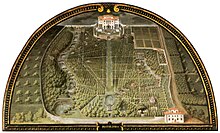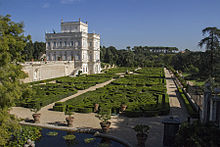Villa
This article needs additional citations for verification. (May 2009) |

A villa is a type of house that was originally an
Roman
This section relies largely or entirely on a single source. (February 2024) |
Roman villas included:
- the villa urbana, a suburban or country seat that could easily be reached from Rome or another city for a night or two
- the villa rustica, the farm-house estate that was permanently occupied by the servants who had charge generally of the estate, which would centre on the villa itself, perhaps only seasonally occupied. The Roman villae rusticae at the heart of latifundia were the earliest versions of what later and elsewhere became called manors and plantations.
- the otium villa, for rural retirement or pleasure
In terms of design, there was often little difference in the main residence between these types at any particular level of size, but the presence or absence of farm outbuildings reflected the size and function of the estate.
Not included as villae were the described the wide range of Roman dwellings. Another type of villae is the "villa maritima", a seaside villa, located on the coast.

A concentration of Imperial villas existed on the Gulf of Naples, on the Isle of Capri, at Monte Circeo and at Antium. Examples include the Villa of the Papyri in Herculaneum; and the Villa of the Mysteries and Villa of the Vettii in Pompeii.
There was an important villa maritima in Barcola near Trieste. This villa was located directly on the coast and was divided into terraces in a representation area in which luxury and power was displayed, a separate living area, a garden, some facilities open to the sea and a thermal bath. Not far from this noble place, which was already popular with the Romans because of its favorable microclimate, one of the most important Villa Maritima of its time, the Miramare Castle, was built in the 19th century.[1]
Wealthy Romans also escaped the summer heat in the hills round Rome, especially around Tibur (Tivoli and Frascati), such as at Hadrian's Villa. Cicero allegedly possessed no fewer than seven villas, the oldest of which was near Arpinum, which he inherited. Pliny the Younger had three or four, of which the example near Laurentium is the best known from his descriptions.
Roman writers refer with satisfaction to the self-sufficiency of their latifundium villas, where they drank their own wine and pressed their own oil. This was an affectation of urban aristocrats playing at being old-fashioned virtuous Roman farmers, it has been said that the economic independence of later rural villas was a symptom of the increasing economic fragmentation of the Roman Empire.
In Roman Britannia
Archaeologists have meticulously examined numerous

Two kinds of villa-plan in Roman Britain may be characteristic of Roman villas in general. The more usual plan extended wings of rooms all opening onto a linking portico, which might be extended at right angles, even to enclose a courtyard. The other kind featured an aisled central hall like a basilica, suggesting the villa owner's magisterial role. The villa buildings were often independent structures linked by their enclosed courtyards. Timber-framed construction, carefully fitted with mortises and tenons and dowelled together, set on stone footings, were the rule, replaced by stone buildings for the important ceremonial rooms. Traces of window glass have been found, as well as ironwork window grilles.
Monastery villas of Late Antiquity
With the
In regions on the Continent,
From the sixth to the eighth century,
Post-Roman era
In post-Roman times a villa referred to a self-sufficient, usually fortified Italian or
inherited the concept, followed by the Carolingian French but the later French term was basti or bastide.Villa/Vila (or its cognates) is part of many Spanish and Portuguese placenames, like
Italian Renaissance

Tuscany
In 14th and 15th century Italy, a villa once more connoted a country house, like the first

These first examples of Renaissance villa predate the age of Lorenzo de' Medici, who added the Villa di Poggio a Caiano by Giuliano da Sangallo, begun in 1470, in Poggio a Caiano, Province of Prato, Tuscany.
From Tuscany the idea of villa was spread again through Renaissance Italy and Europe.
Tuscan villa gardens
The Quattrocento villa gardens were treated as a fundamental and aesthetic link between a residential building and the outdoors, with views over a humanized agricultural landscape, at that time the only desirable aspect of nature. Later villas and gardens include the Palazzo Pitti and Boboli Gardens in Florence, and the Villa di Pratolino in Vaglia.
Rome
Rome had more than its share of villas with easy reach of the small sixteenth-century city: the progenitor, the first

The
The cool hills of
Near
Venice
In the later 16th century in the northeastern Italian Peninsula the Palladian villas of the Veneto, designed by Andrea Palladio (1508–1580), were built in Vicenza in the Republic of Venice. Palladio always designed his villas with reference to their setting. He often unified all the farm buildings into the architecture of his extended villas.
Examples are the
The Villas are grouped into an association (Associazione Ville Venete) and offer touristic itineraries and accommodation possibilities.
Villas elsewhere
17th century
Soon after in

18th and 19th centuries
In the early 18th century the English took up the term, and applied it to compact houses in the country,[2] especially those accessible from London: Chiswick House is an example of such a "party villa". Thanks to the revival of interest in Palladio and Inigo Jones, soon Neo-Palladian villas dotted the valley of the River Thames and English countryside. Marble Hill House in England was conceived originally as a "villa" in the 18th-century sense.[3]
In many ways the late 18th century
In the nineteenth century, the term villa was extended to describe any large suburban house that was free-standing in a landscaped plot of ground. By the time 'semi-detached villas' were being erected at the turn of the twentieth century, the term collapsed under its extension and overuse.

The second half of the nineteenth century saw the creation of large "Villenkolonien" in the German speaking countries, wealthy residential areas that were completely made up of large mansion houses and often built to an artfully created masterplan. Also many large mansions for the wealthy German industrialists were built, such as Villa Hügel in Essen. The Villenkolonie of Lichterfelde West in Berlin was conceived after an extended trip by the architect through the South of England. Representative
In France the

20th – 21st centuries
Europe

During the 19th and 20th century, the term "villa" became widespread for detached mansions in Europe. Special forms are for instance spa villas (Kurvillen in German) and seaside villas (Bädervillen in German), that became especially popular at the end of the 19th century. The tradition established back then continued throughout the 20th century and even until today.
Another trend was the erection of rather minimalist mansions in the Bauhaus style since the 1920s, that also continues until today.
In Denmark, Norway and Sweden "villa" denotes most forms of single-family detached homes, regardless of size and standard.
Americas
The villa concept lived and lives on in the
, and other architects developing a unique Euro-Latin synthesized aesthetic.Villas are particularly well represented in California and the West Coast of the United States, where they were originally commissioned by well travelled "upper-class" patrons moving on from the Queen Anne style Victorian architecture and Beaux-Arts architecture. Communities such as Montecito, Pasadena, Bel Air, Beverly Hills, and San Marino in Southern California, and Atherton and Piedmont in the San Francisco Bay Area are a few examples of villa density.
The popularity of
Modern villas


Modern architecture has produced some important examples of buildings known as villas:
- Villa Noailles by Robert Mallet-Stevens in Hyères, France
- Villa Savoye by Le Corbusier in Poissy, France[6][7]
- Villa Mairea by Alvar Aalto in Noormarkku, Finland[8][9]
- Villa Tugendhat by Ludwig Mies van der Rohe in Brno, Czech Republic
- Vertner Tandy in Irvington, New York
Country-villa examples:
- Hollyhock House (1919) by Frank Lloyd Wright in Hollywood
- Gropius House by Walter Gropius (1937) in Lincoln, Massachusetts
- Fallingwater by Frank Lloyd Wright (1939) in Pennsylvania, U.S.
- Farnsworth House by Ludwig Mies van der Rohe in Plano, Illinois
- Kaufmann Desert House by Richard Neutra (1946) in Palm Springs, California
- Auldbrass Plantation by Frank Lloyd Wright (1940–1951) in Beaufort County, South Carolina
- Palácio da Alvorada by Oscar Niemeyer (1958) in Brasília, Brazil
- Getty Villa, in Pacific Palisades, Los Angeles
Other
Today, the term "villa" is often applied to
In Indonesia, the term "villa" is applied to Dutch colonial country houses (landhuis). Nowadays, the term is more popularly applied to vacation rental usually located in countryside area.
In Australia, "villas" or "villa units" are terms used to describe a type of townhouse complex which contains, possibly smaller attached or detached houses of up to 3–4 bedrooms that were built since the early 1980s.
In South Korea, the term "villa" refers to small multi-household house with 4 floors or less.[12]
In Cambodia, "villa" is used as a loanword in the local language of Khmer, and is generally used to describe any type of detached townhouse that features yard space. The term does not apply to any particular architectural style or size, the only features that distinguish a Khmer villa from another building are the yard space and being fully detached. The terms "twin-villa" and "mini-villa" have been coined meaning semi-detached and smaller versions respectively. Generally, these would be more luxurious and spacious houses than the more common row houses. The yard space would also typically feature some form of garden, trees or greenery. Generally, these would be properties in major cities, where there is more wealth and hence more luxurious houses.
See also
Notes
- ^ Zeno Saracino: "Pompei in miniatura": la storia di "Vallicula" o Barcola. In: Trieste All News. 29 September 2018.
- ^ These are not to be confused with the English country houses, which were centres of political and cultural power and show surrounded by the estates that supported them, such as Holkham Hall, Alnwick Castle or Woburn Abbey; in Ireland Castletown House and Russborough House are comparable examples.
- ^ Sir John Summerson, Architecture in Britain, 1530 to 1830: ch. 22 "Palladian permeation: the villa" provides a standard overview of the building type.
- ISBN 978-3-86468-160-8.
- ^ "Museokortti-kohde: Hakasalmi Villa". www.museot.fi.
- ^ "Bienvenue à la villa Savoye à Poissy". www.villa-savoye.fr.
- ^ Gibson, Eleanor (31 July 2016). "dezeen.com, Le Corbusier's Villa Savoye encapsulates the Modernist style".
- ^ "Villa Mairea – Villa Mairea".
- ^ "Villa Mairea by Alvar Aalto at GreatBuildings". GreatBuildings.
- ^ "Villa | BRANZ Renovate". BRANZ Renovate. 2010-06-07. Retrieved 2021-07-31.
- ^ "Villa Casa Mia | Villa Renovate". Villa Casa Mia Renovate. 2014-08-07. Retrieved 2022-01-01.
- ^ "[Survive & Thrive] Korean 'villas' are not what you expect". The Korea Herald. 18 April 2023. Retrieved 15 July 2023.
